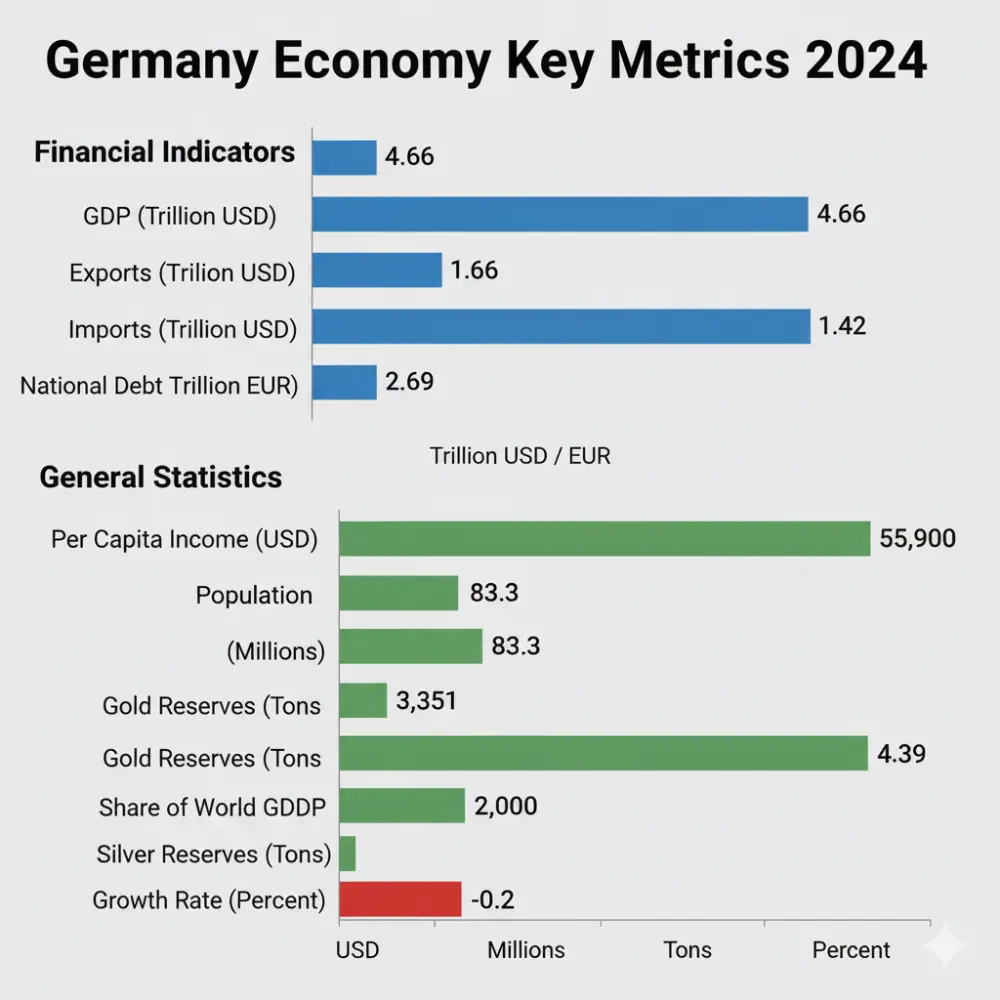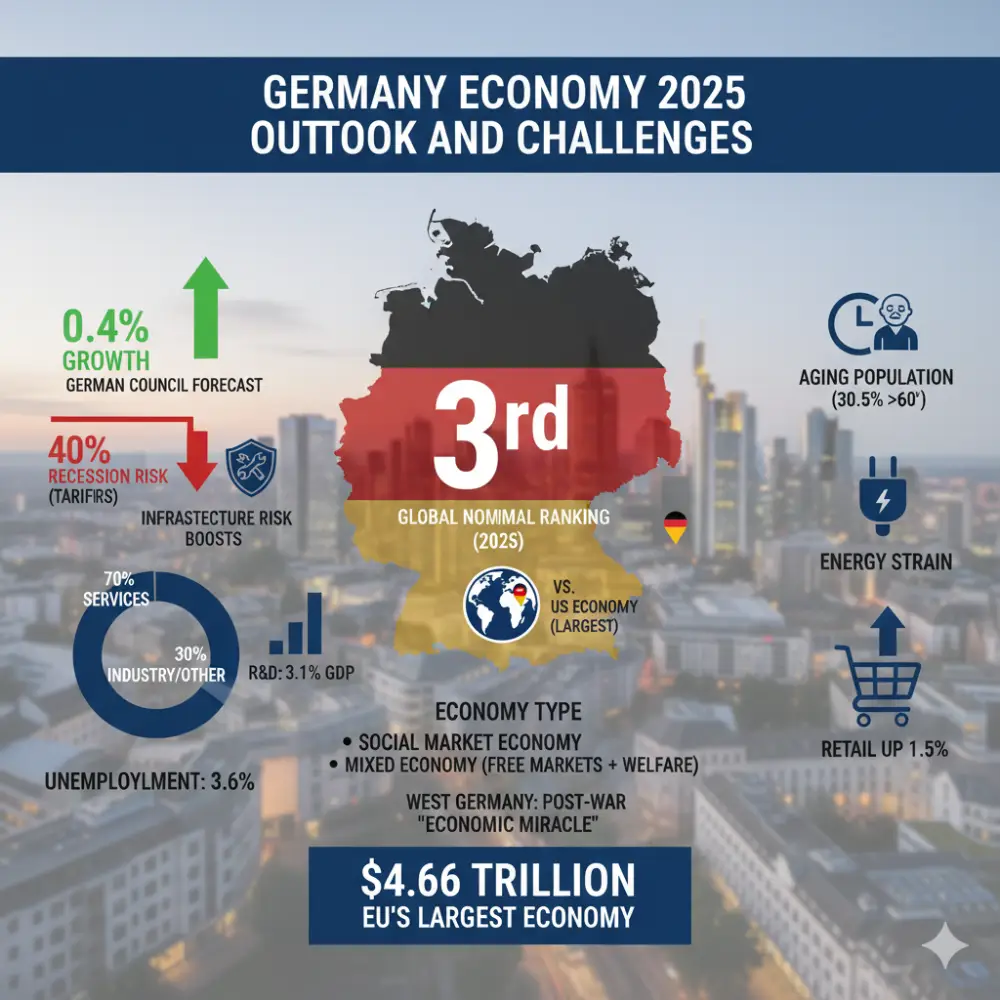The Germany Economy in 2024 faced headwinds but held ground with a GDP of $4.66 trillion, down 0.2% from 2023. This kept its 4.39% share of world GDP steady amid global shifts. With 83.3 million people, per capita1 income stood at $55,900. Exports reached $1.66 trillion, slightly edging imports at $1.42 trillion for a $255 billion surplus. These numbers counter talk of Germany economy collapse2, showing resilience in manufacturing and services.
Key 2025 Data on Germany Economy Performance
Analysts eye Germany economy growth for recovery signals. The -0.2% dip marked two straight years of contraction, hit by energy costs and weak demand. Quarterly figures varied: Q1 up 0.2%, Q2 down 0.3%, Q3 up 0.1%, and Q4 down 0.2%. Yet, services grew 1.1% year-on-year, lifting overall output.
Folks ask, how is Germany economy doing? Exports to the US hit €65 billion in the first 11 months, but global slowdowns bit. Gold reserves at 3,351 tons offered a firm base.
Quick stats3 list:
- GDP: $4.66 trillion
- Growth Rate: -0.2%
- Per Capita Income: $55,900
- World GDP Share: 4.39%
- Population: 83.3 million
These link to broader global GDP trends, where Germany ranks third.
Trade and Debt in the 2025 Germany Economy
Trade anchors the Germany Economy. Exports topped $1.66 trillion, led by cars (17%) and machinery (14.2%). Imports at $1.42 trillion focused on vehicles ($160 billion) and pharma ($80 billion). The $255 billion surplus ranked second worldwide, but fell 1% from 2023.
Debt hit €2.69 trillion, or 62.5% of GDP—up €57 billion but down from 62.9%. The central government added €36 billion, states €15 billion. Reserves steady: gold at 3,351 tons, silver negligible for monetary use but industrial stocks around 2,000 tons.
Manage debt with:
- Boost EU trade pacts.
- Cut energy imports via renewables.
- Tap reserves for stability.
These aid navigation in economic globalization.
Table of Facts and Figures
After reviewing 2024 metrics, this table captures the Germany Economy‘s snapshot—contraction amid trade strength:
| Indicator | Value | Unit | Notes |
| GDP | 4.66 | Trillion USD | Total output, third globally |
| Growth Rate | -0.2 | Percent | Annual contraction |
| Population | 83.3 | Million | Steady amid aging trends |
| Per Capita Income | 55,900 | USD | High among Europeans |
| Share of World GDP | 4.39 | Percent | Solid EU leader |
| Imports | 1.42 | Trillion USD | Up in pharma, vehicles |
| Exports | 1.66 | Trillion USD | Cars, machinery drive surplus |
| National Debt | 2.69 | Trillion EUR | 62.5% of GDP |
| Gold Reserves | 3,351 | Tons | Key stability asset |
| Silver Reserves | 2,000 | Tons | Industrial focus, not monetary |

Germany Economy News and Tariff Pressures
Recent germany economy news today flags trump tariffs impact on germany economy. Proposed 25-50% US duties on autos and steel could shave 0.5% off GDP, per experts. In 2024, US trade hit €253.3 billion, with exports down 2.3% in metals.
Germany economy news today October 2025 looks back at 2024’s export drop to China (1.7% loss), but EU ties held firm at 54.5%. Factory output fell 4.8% in iron/steel.
For businesses:
- Shift sales to Asia markets.
- Lobby for EU countermeasures.
- Stockpile ahead of hikes.
These will be built on 2024’s base.
Germany Economy 2025 Outlook and Challenges
The Germany economy 2025 outlook predicts 0.4% growth, per the German Council. Germany economy 2025 eyes infrastructure boosts, but Germany economy recession 2025 risks linger at 40% if tariffs bite. Unemployment may hit 3.6%.
Does Germany have a good economy? Yes, with services at 70% of GDP and R&D at 3.1%. Germany economy issues like aging (30.5% over 60) and energy strain persist, but retail up 1.5%.
Where does Germany rank in economy? Third nominal, per world economy ranking 2025. Compared to the US economy for contrast.
What type of economy does Germany have? A social market economy—is Germany a mixed economy? Yes, blending free markets with welfare. What type of economy did West Germany have? Similar post-war model, fueling the “economic miracle.”
How big is Germany economy? $4.66 trillion, Europe’s largest.

Germany Economy Updates Today: Current Vibes
Germany economy updates today show inflation at 2.2%, down from peaks. Germany economy news may 2025 noted Q1 recovery, while germany economy news april 2025 warned of industrial dips. Germany economy overview 2025 stresses green shifts, with EV exports up 5.6%.
What is the economy of Germany? Export-led, with pharma and aircraft growing 3.6%. How is the economy in Germany? Stabilizing, but watch debt at 62.5%.
Germany economy type? Market-oriented with state oversight—what kind of economy is Germany? Adaptive and innovative.
Historical Roots of the Germany Economy
Post-WWII, West Germany’s type of economy sparked the Wirtschaftswunder, growing 8% yearly via exports. Reunification in 1990 blended systems, lifting output 40-fold since. These foundations drive today’s Germany economy ranking, third globally.
What economy does Germany have? One that turned ruins to riches, now facing modern tests.
Germany Economy Overview Amid EU Role
Germany economy overview highlights 50.3% export reliance, powering 29.1% industry share. What is germany economy? A powerhouse with 29 Fortune 500 firms. What is the economy like in Germany? Competitive, with a low 2.8% deficit.
Is Germany a market economy? Yes, social variant—what economy is Germany? Balanced and export-focused.
FAQs on the Germany Economy
What kind of economy does Germany have?
Social market, with -0.2% growth in 2024.
How is Germany economy?
Resilient, eyeing 0.4% rebound.
What is the economy in Germany?
$4.66T GDP, strong in autos.
Germany economy 2024?
Contracted 0.2%, but surplus held.
Conclusion
In conclusion, the Germany Economy navigated 2024’s -0.2% dip to $4.66T GDP, with $255B surplus and 3,351 tons gold as anchors. Tariffs and slowdowns challenge, but reforms promise lift. Track via world economy. What fix do you see for the Germany Economy‘s export woes?
References
- World Bank and IMF for per capita and shares. ↩︎
- Deutsche Bundesbank for debt and reserves. These suit investors, policymakers, and students eyeing Europe’s core for strategies. ↩︎
- German Federal Statistical Office (Destatis) for GDP and trade data. ↩︎